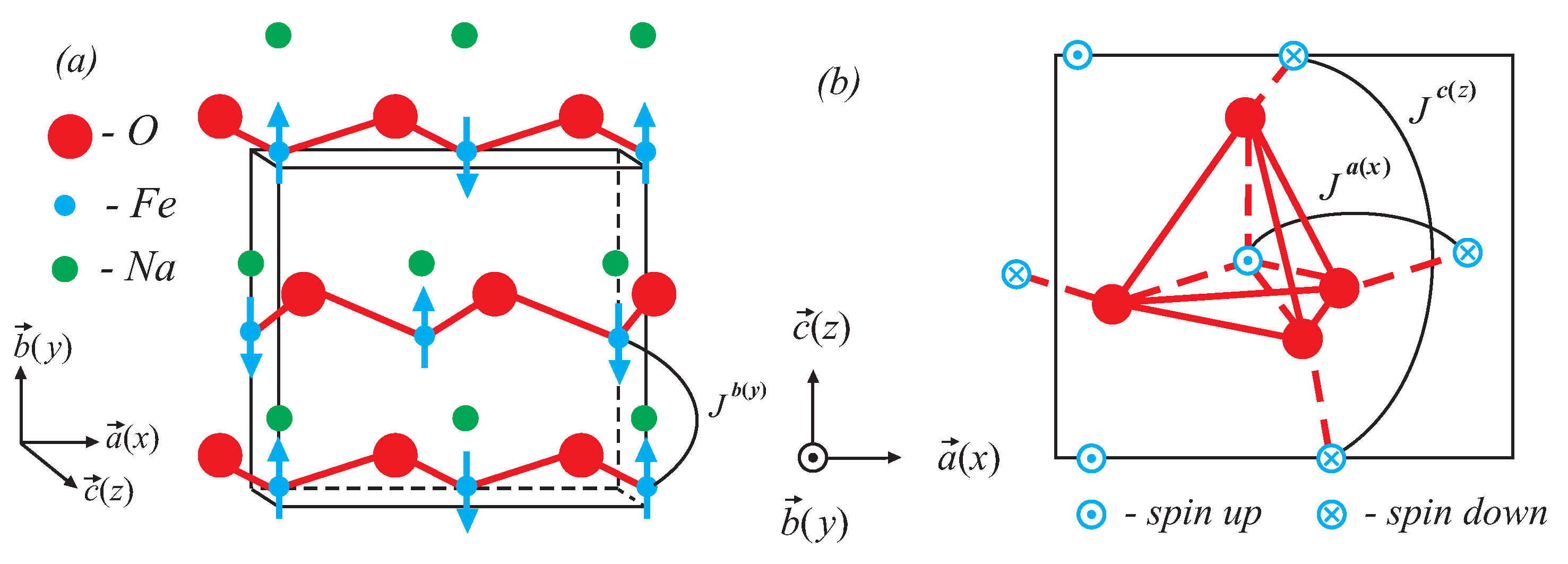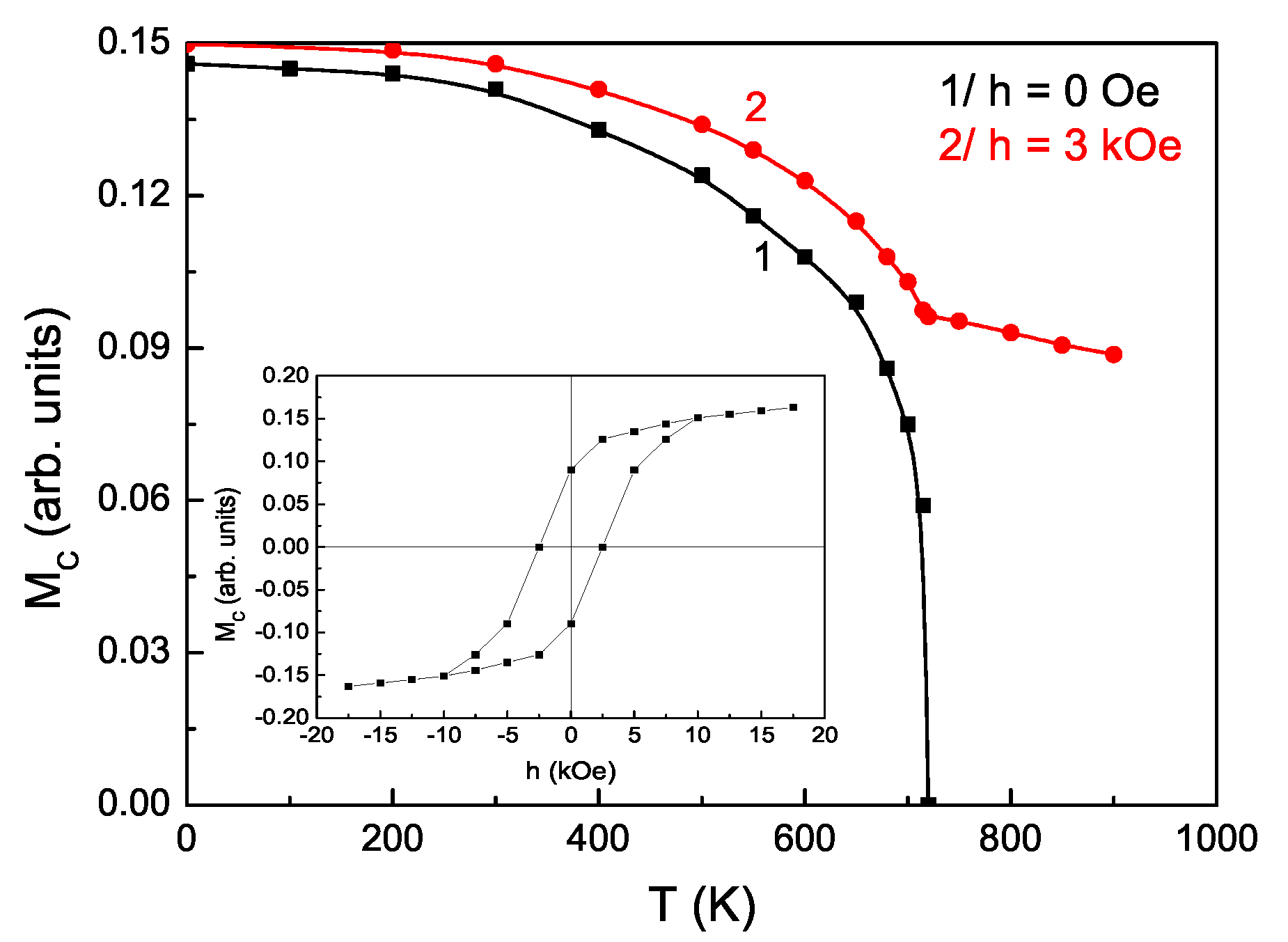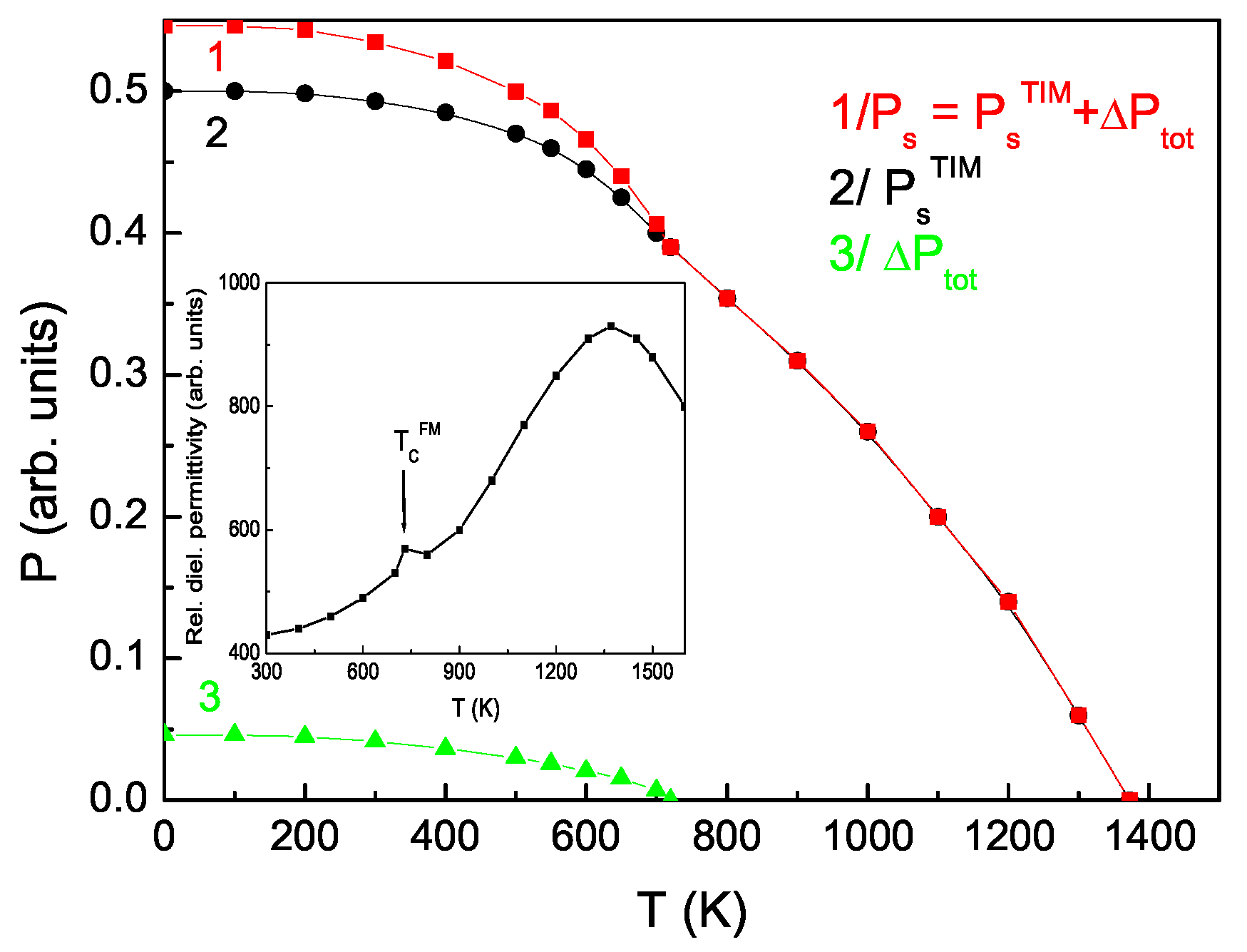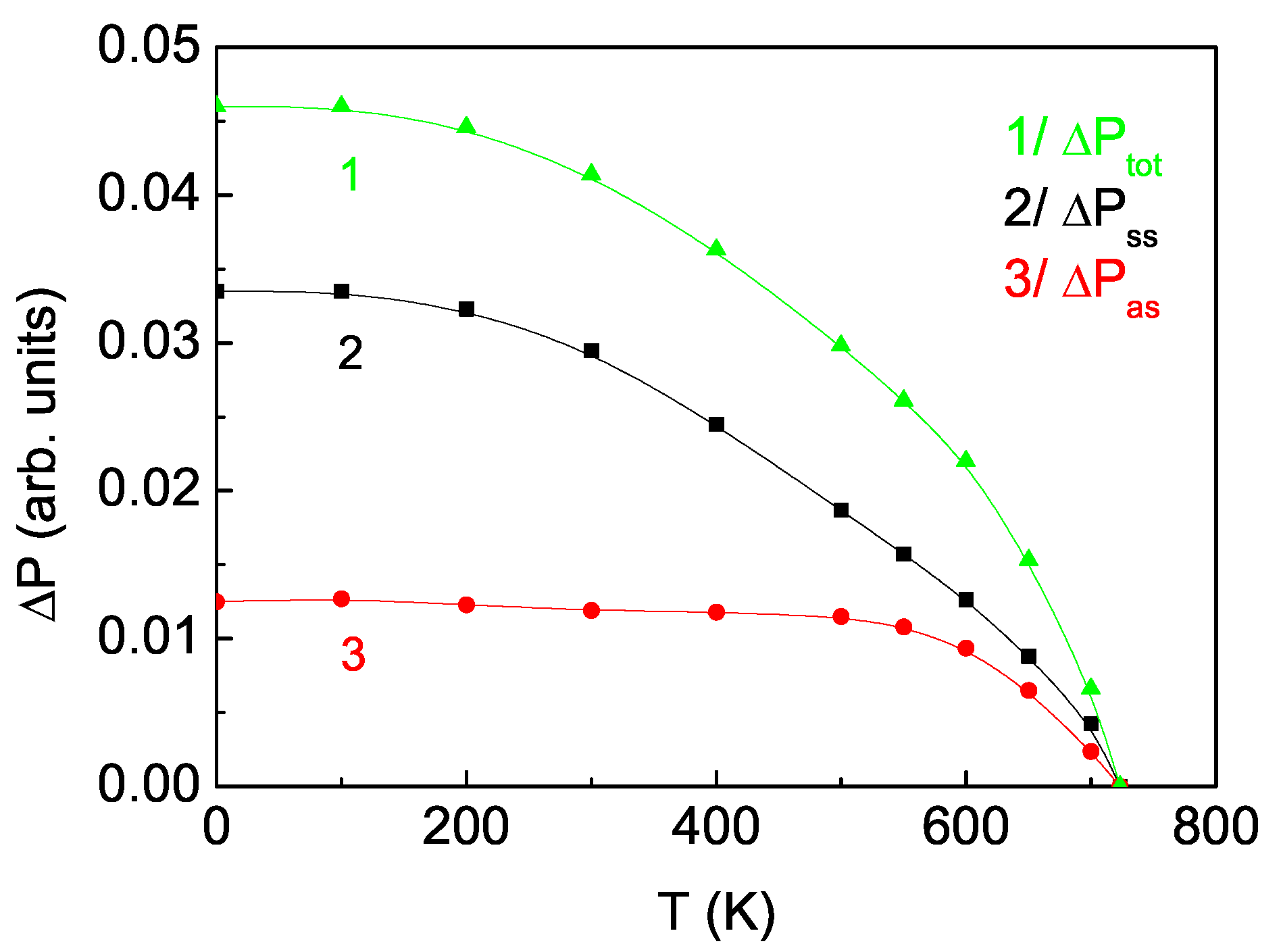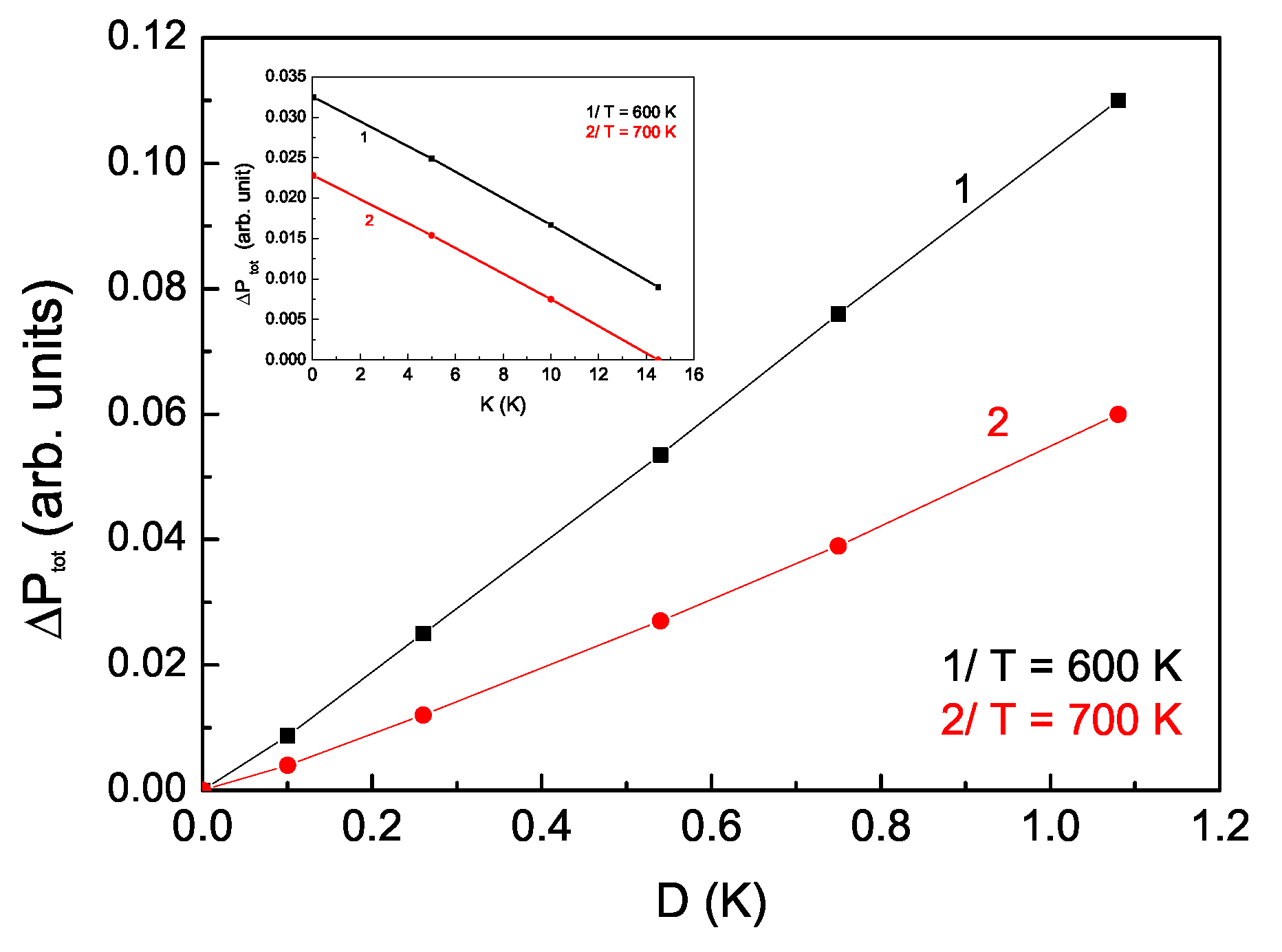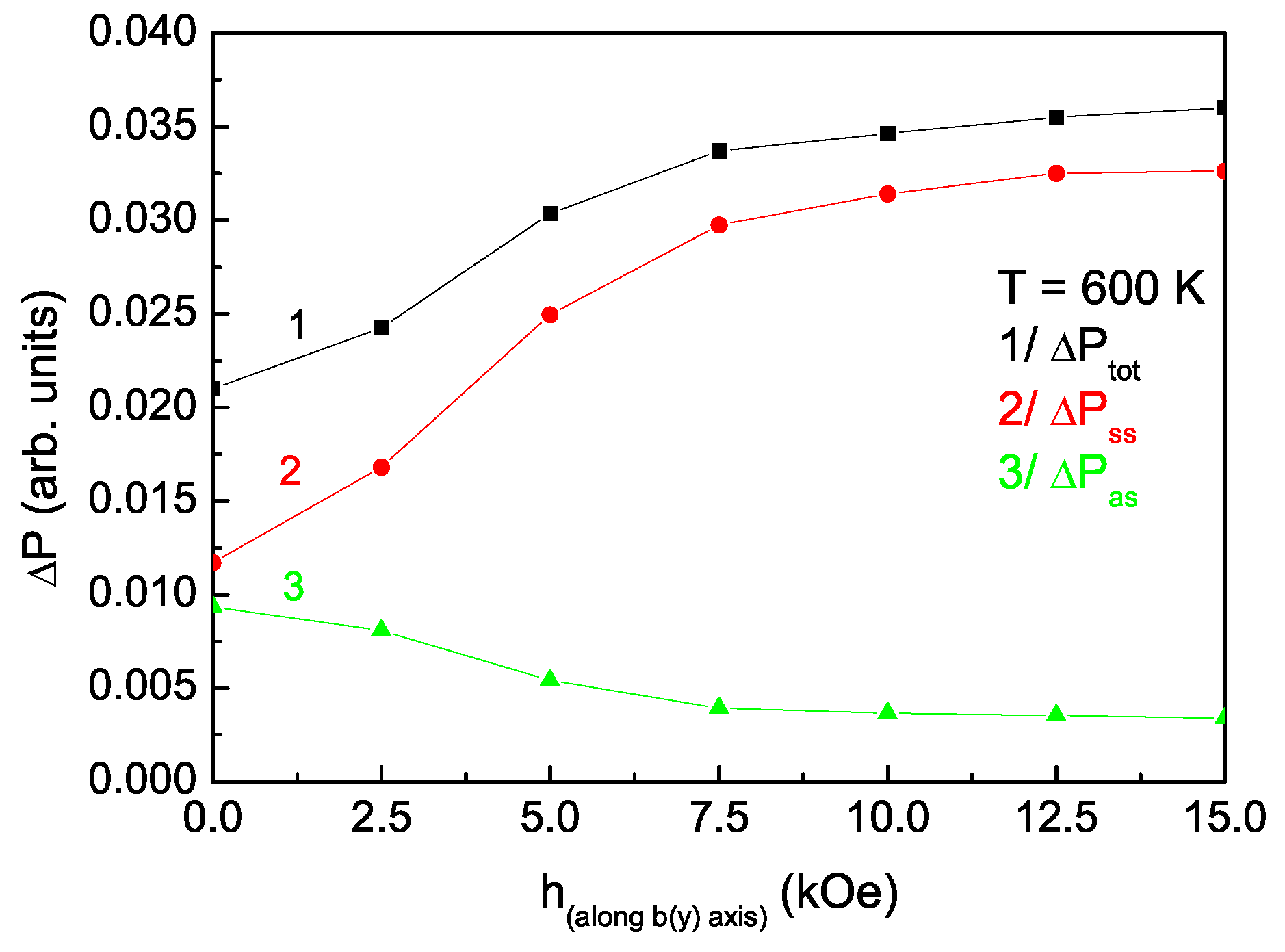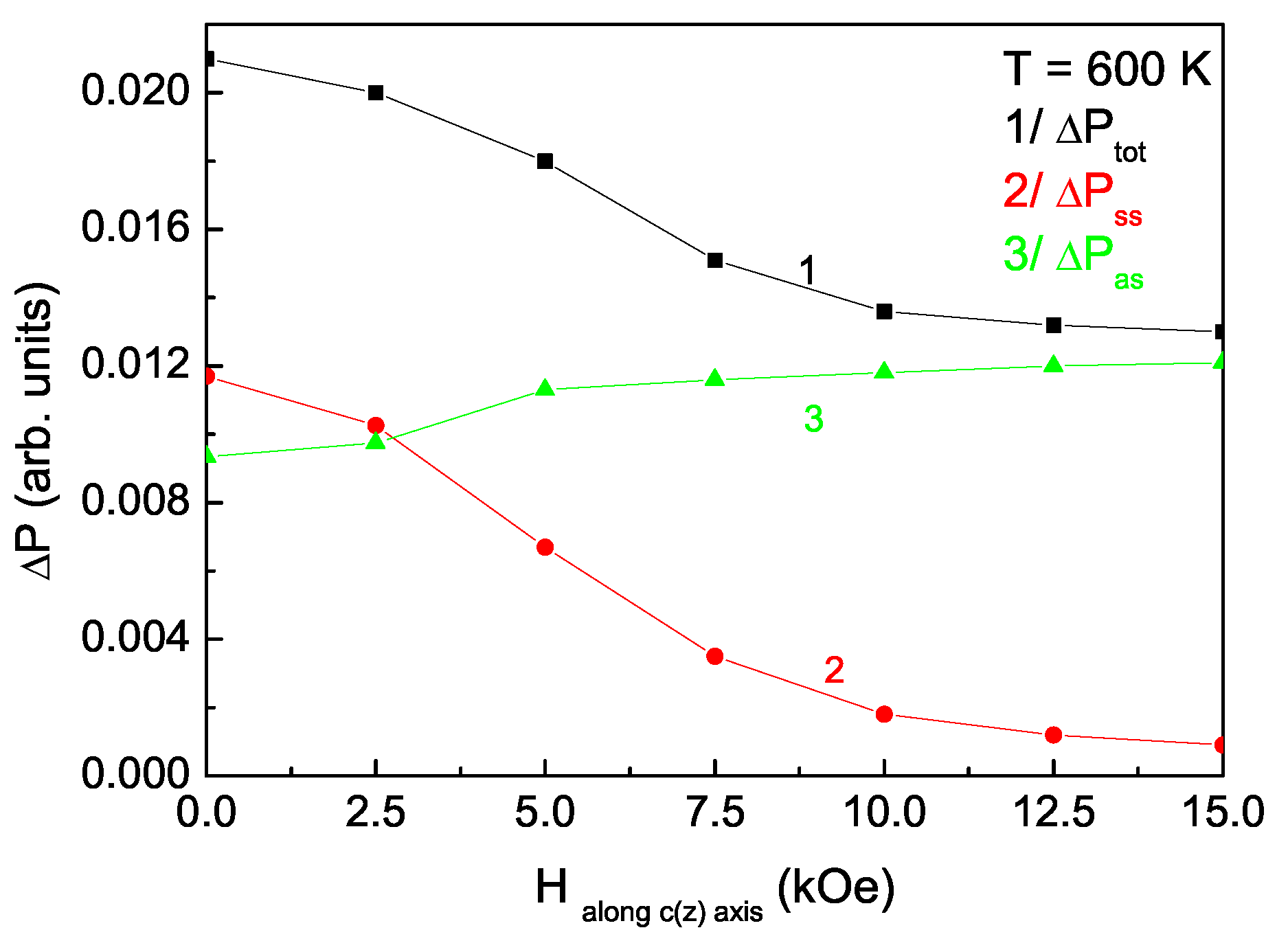2. The Model
-NFO crystallizes in a non-centrosymmetric orthorhombic structure Pn2
a (see
Figure 1) with lattice parameters
a = 5.6793
,
b = 7.1243
and
c = 5.3784
[
1]. The Fe
ions form a monoclinic lattice, where each magnetic ion has four nearest neighbors. The basic magnetic interaction is a super-exchange one Fe-O-Fe with an angle 113
–126
[
2], which is not optimal for antiferromagnetic ordering. Neutronographic studies have shown that the magnetic moments of Fe
are arranged in a G-type antiferromagnetic structure along the
axis with a phase transition temperature of
= 723 K [
1]. Magnetic measurements indicate the presence of a weak ferromagnetism with a spontaneous magnetic value of about
/cell at room temperature with a deviation from the antiferromagnetic arrangement of 0.003
[
1]. This behavior is a consequence of the presence of an antisymmetric DM exchange interaction. For symmetric reasons, it is clear that if the antiferromagnetic order is along the
axis, the appearance of the WFM is along the
axis as the DM vector has the form
=
. The sign and direction of the DM vector provides the relationship between the coordinates of the Fe ions in the elementary cell for each Fe-O-Fe bond [
9]. Following the peculiarities of the crystalline structure, it is clear that the symmetric operators
n and
a do not impose any restriction on the polarization vector. The operator
(determining a rotation of 180
around the
axis) changes the atomic positions from
in
. This means that the polarization will only have a component along the
axis [
10].
The magnetic properties of
-NFO are described by a modified Heisenberg Hamiltonian
:
where
is the Heisenberg spin operator of the Fe ion at the site
i.
J is the symmetric exchange interaction,
K is the constant of the single-ion magnetic anisotropy,
g is the gyromagnetic factor, and
is the Bohr magneton. The first three terms in (1) describe the isotropic super-exchange interactions in the magnetic system as:
(see
Figure 1b). This determines a ferromagnetic arrangement along the
z axis,
(see
Figure 1b) and
(see
Figure 1a) determines an antiferromagnetic arrangement along the
x and
y axis, respectively. The fourth term includes the antisymmetric exchange DM interaction type and is responsible for the appearance of a weak ferromagnetism along the
z axis. The fifth term in (1) defines the
y-axis as the easy axis of the magnetization, i.e.,
.
is an external magnetic field.
Since the crystal lattice of
-NFO is non-centrosymmetric, the spontaneous polarization appears at temperatures higher than
. At temperatures above
= 1373 K
-NFO is in a paraelectric state, where the lattice symmetry is tetragonal (the so-called
-NFO). This means that, at
= 1373 K, there is a structural phase transition from a paraelectric P4
2
2 centrosymmetric tetragonal phase into a non-centrosymmetric orthorhombic structure Pn2
a [
1]. This is a phase transition of a displacive type. The polarization properties can be described using the pseudo-spin formalism and the transverse Ising model (TIM)
, considering that, from a symmetrical point of view, the polarization is on the
y axis:
The pseudo-spin operator
characterizes the two positions of the ferroelectric unit at the lattice point
i.
denotes the nearest-neighbor pseudo-spin interaction. The dynamics of the ferroelectric part are realized by the first term with the flipping rate
and the operator
. The TIM was proposed by Blinc and de Gennes, describing order–disorder and displacive type ferroelectrics [
11,
12].
For
-NFO the Fe
, ions are involved in the formation of the polar state through their displacements, together with those of the Na
ions relative to the oxygen matrix. Moreover, the same iron ions, due to super-exchange interactions, are responsible for the appearance of a G-type magnetic ordering and a weak ferromagnetism. This means that these compounds must be defined as multiferroics, in which an additional, spin-assisted polarization
is also observed. From a theoretical perspective, the appearance of the magnetoelectric terms in the Hamiltonian
is a consequence of the modulation of the symmetric and antisymmetric exchange interactions between the Fe
spins from the polar lattice displacements
. Considering that
, where
is the Born charge,
can be written as:
and
are the first derivatives of the exchange interaction
J and of the DM vector on the polar displacements
, respectively, and
is the second derivative of
J on
. The terms in (3) are formally similar to the Peierls-type spin–phonon interactions. Note that
is responsible for the change in the hybridization of the magnetic Fe-O-Fe and Fe-O-O-Fe bonds, i.e., under
, the magnetic arrangement is influenced by the spontaneous polarization.
Finally, the total Hamiltonian for the description of the multiferroic properties of
-NFO takes the form:
Comparing the third term in Equation (
3) with the fourth one in (1), it can be concluded that the spontaneous polarization induces a DM interaction with a vector
. This leads to an effective temperature-dependent DM vector:
which, below
increases, with decreases in temperature.
Analogically, the first and second terms in Equation (
3) mean that the isotropic exchange interaction
J is also temperature-dependent:
Qualitatively, Equations (5) and (6) define a kind of a feedback connection between the two subsystems. The spontaneous polarization changes the nature of the symmetric and antisymmetric exchange interactions. However, below the ferromagnetic phase transition temperature , due to the magnetic ordering, the spontaneous polarization will be changed and “controlled” through renormalization of the pseudo-spin interaction and the tunneling rate by applying a magnetic field and the appearance of a spin-assisted additive polarization .
Let us emphasize that a strong spin–phonon interaction is reported in ABO
compounds (A = Cu, Ag, Na, Li and B = Fe, Cr) [
13]. Therefore, a further polarization may be a consequence of magnetostriction (MS) effects:
or (and) inverse DM mechanism [
14]:
where
d are the components of
. The second mechanism is characteristic for compounds in which non-collinear magnetic structures (commensurate and non-commensurate spirals) are observed, and for crystals, which have a two fold axis perpendicular to
, or a mirror plane of symmetry containing
. In our opinion, this is not the case in
-NFO. As Kaplan et al. [
10] have shown, in the absence of such elements of symmetry, an additional polarization resulting from the DM interaction will appear:
Therefore the spin-assisted polarization is calculated from the following equation:
From Equation (
2), it can be seen that the ferroelectric ordered phase is characterized by non-zero mean values of
and
. In order to obtain, below the ferroelectric phase-transition temperature
, one order of parameter that determines spontaneous polarization, the coordinate system is rotated around the
x axis at about an angle of
, which is the angle locked between the direction of the pseudo-spin vector and the positive direction of the
y-axis.
is determined from the requirements of
in the new coordinate system:
is the pseudo-spin wave energy observed from the poles of the Green’s function .
From the 3 × 3 matrix Green’s function
, the expression for the magnetization
is calculated as follows:
where
is the spin-wave energy.
For the spin-assisted additive polarizations, we have observed:
The correlation functions are obtained using the Spectral theorem.
3. Numerical Results and Discussion
For the numerical calculations of the properties of -NFO, we will use the following model parameters for the magnetic subsystem: = −61.94 K, = 17.27 K, = −9.84 K, d = 0.26 K, K = 0.034 K, S = 5/2, = 723 K. For the ferroelectric subsystem, we use the following: = 1472.28 K, = 16.47 K, s = 1/2, = 1373 K.
We will provide a short description of the calculation of some model parameters. From
Figure 1b, it can be seen that, along the
a axis, the spins are ordered antiferromagnetically, with type Fe-O-Fe. Along the
c axis, the spins are ordered ferromagnetically, with type Fe-O-O-Fe (next nearest neighbors) (
Figure 1b), which leads to a smaller interaction compared to that along the
a axis. The exchange interaction
along the
x axis in the
plane is approximately observed from the expression in the mean field approximation
, where
is the Boltzmann constant,
z = 4 is the number of nearest neighbors,
S = 5/2 is the spin value, and
is the magnetic critical temperature. The above expression for
determines the magnitude of the exchange interaction value while the magnetic configuration is its sign. There is an antiferromagnetic arrangement along the
x-axis (see
Figure 1b). This means that the sign of
is negative. Finally, we find that
= −61.94 K. It must be noted that the units for all exchange interactions are shown in Kelvin [K] as
K [
15].
along the
z axis is calculated, considering the dependence of the magnetic exchange interaction constant on the distance
r between two neighbouring spins,
, as follows:
= 17.27 K. Using the same assumption, we observe for
= −9.84 K. Following [
16], we can observe the DM constant from the relation between the canting angle
and the value of the DM vector
D:
. With
= 0.003
[
1], i.e.,
, we can observe
= 0.26 K. The model parameters for the ferroelectric subsystem
and
are calculated from the following expressions:
,
, below
and
≈
with
40–45 K (the energies of the ferroelectric system assumed within our model) at very high temperatures [
11].
Firstly, we will study the magnetic field and temperature dependence of the magnetization of
-NFO. The results are presented in
Figure 2. We observe that
-NFO exhibits a WFM, a magnetization
along the
c axis, which is in agreement with the experimental data of Viret et al. [
1] and Watanabe et al. [
2]. The WFM decreases with increasing temperature and vanishes for a magnetic field
h = 0 at a critical temperature
= 723 K. We also investigated the influence of an external magnetic field
h in the
c direction on the magnetization
. The hysteresis is shown as being inset in
Figure 2. It can be seen that this shows a typical ferromagnetic behavior. This behavior could be due to the spin-canted Fe moments, to the competition between antiferromagnetic super-exchange and ferromagnetic interactions, or to the antisymmetric DM interactions. It should be mentioned that the latter could also depend on the coupling between local spins and electrical polarization. Let us emphasize that the DM interaction, which is the main origin of the WFM, leads to its increase. For
D = 0, there is not a WFM, the magnetization
is zero.
Figure 3 shows the temperature dependence of the spontaneous polarization
along the
b axis, which vanishes at
= 1373 K, a phase transformation from the orthorhombic to tetragonal phase. The hysteresis of
is reported by Viret et al. [
1]. In
, there are two contributions: curve 2 describes the spontaneous polarization observed from the TIM
, whereas curve 1 describes the behavior of
, also considering the ME interactions in
-NFO. At
= 723 K, a “kink” is observed (see curve 1). The additional contribution in
is due to the appearance under
of an additional spin-dependent polarization
(curve 3), which is due to the MS and the antisymmetric DM interaction. In the “inset”, the temperature dependence of the relative dielectric permittivity
is presented, where a peak is observed at the magnetic-phase transition temperature
. This is evidence of the presence of ME interactions in
-NFO. The appearance of the additional polarization
, which is spin-dependent, determines the possibility of controlling
in this compound within an external magnetic field
h at room temperature.
The relative dielectric permittivity
is calculated from equation [
17]:
where
is wave vector,
E is energy or frequency, the indices
are the components of the related spins,
is the delta function,
Z is the electron charge and
v is the volume. To study the relative dielectric permittivity
, we need the Green’s function
:
and are the transverse pseudo-spin wave energy and its damping.
The contributions of each of the mechanisms to
are presented in the next Figure. From the temperature dependence of
(see
Figure 4, curve 1), this can be seen to disappear at the magnetic-phase transition temperature
. Curves 2 and 3 determine the contributions of the two mechanisms to the additional polarization,
and
, due to the MS and the antisymmetric DM interaction, respectively. It is clear that the additional polarization associated with the MS (curve 2) prevails over that due to the DM-related interaction (curve 3).
Figure 5 presents the dependence of the spin-dependent polarization
on the DM vector
D, whereas the inset shows the dependence on the magnetic anisotropy constant
K for different temperature values (curves 1 and 2). As
D increases, the value of the additional polarization increases, while as
K grows, it decreases. These results are expected because the antisymmetric magnetic interaction (the intensity of which depends on the size of the DM vector
D) determines the presence of a magnetoelectric (ME) mechanism (see the third term in Equation (
3)) for the occurrence of the additional polarisation
(see Equation (
9)). As
D grows, the “canting” angle and WFM will increase, leading to an increase in the contribution of
. However, enhancing
K will lead to stabilization of the antiferromagnetic G-structure, a decrease in the “canting” angle, and the WFM. The contribution of
due to the antisymmetric DM interaction decreases; therefore,
also decreases.
Figure 6 shows the dependence of the additional spin-dependent polarisation as a function of an external magnetic field applied in the
y direction at a fixed temperature below
. As the field increases, the influence of the spin-dependent polarization increases (curve 1). However, the components of
with the field are different. Using the MS mechanism,
increases as the magnetic field increases (curve 2), while
decreases (curve 3). In contrast, when the applied magnetic field is along the
z axis (see
Figure 7) the influence of the spin-assisted polarization decreases when the magnetic field increases (curve 1), as
decreases with the field (curve 2), whereas
increases (curve 3). This means that there is competition between the two mechanisms and, when the field increases, depending on its direction, the two mechanisms will always have different behaviors (if one mechanism leads to an increase in the polarization
, the other will lead to its reduction). As a result, in an external magnetic field applied in the
y direction, the spontaneous polarization
of the system will increase as the field increases, while, if
h is in the
z direction,
will decrease. The dynamics in the change in the spontaneous polarization is mainly determined by the MS mechanism (this is more sensitive to changes in the value of the field compared to those due to DM interactions).
From a theoretical perspective, the reason for the dependence of the spontaneous polarization on the direction and size of the field below is, in our opinion, due to the influence of the ME mechanisms on the basic microscopic parameters of the pseudo-spin system, namely, on the flipping rate and pseudo-spin interchange interaction . Below the magnetic phase transition temperature, they are renormalized and spin-dependent. Theoretical calculations lead to the following expressions: and where . From these expressions, it is clear that the ME interaction due to the MS renormalizes the pseudo-spin exchange interaction , whereas the ME interaction connected with the DM interaction renormalizes the flipping rate . The numerical calculations show that, with a constant temperature and increasing magnetic field along the y axis, increases, which, according to the TIM, will decrease , i.e., the antisymmetric ME interaction destabilizes the ferroelectric phase. Under the same conditions, the calculations show that would increase, which, according to the TIM, means that would also increase, i.e., the ME interaction connected with the MS stabilizes the ferroelectric phase. However, for h in the direction of the z axis at a constant temperature, the numerical calculations indicate that decreases with increasing h, which means that following the TIM, would increase, i.e., the antisymmetric ME interaction will stabilize the ferroelectric phase. Under the same conditions, the calculations show that would decrease, which, within the TIM, means that would also be reduced, i.e., the ME interaction associated with the MS would destabilize the ferroelectric phase. The magnetic field dependence of the polarization is evidence for the multiferroic behavior of -NFO. Unfortunately, to our knowledge, there are no experimental data for the the temperature and magnetic field dependence of the polarization .
